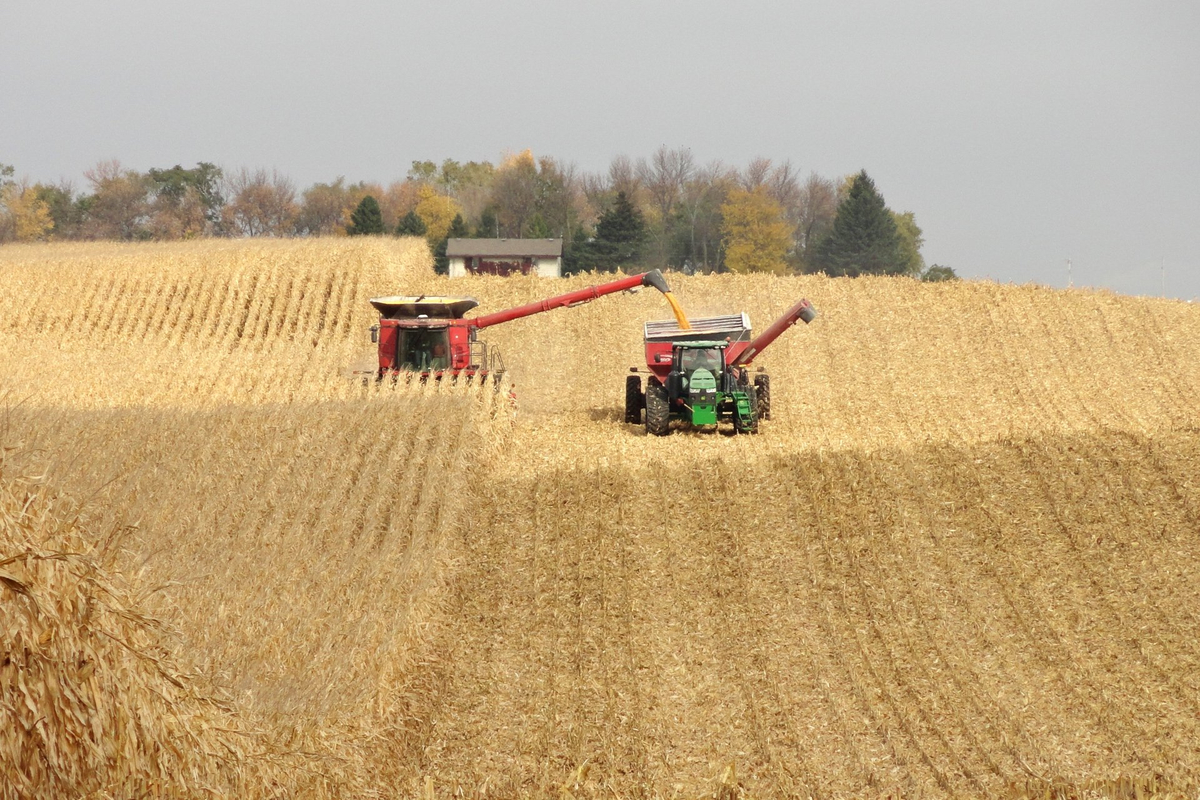November 22, 2025 | 20:49 GMT +7
November 22, 2025 | 20:49 GMT +7
Hotline: 0913.378.918
November 22, 2025 | 20:49 GMT +7
Hotline: 0913.378.918
Grains are among the most in-demand commodities in the Vietnamese market. Meanwhile, the US is a global powerhouse in grain production, boasting high output, superior quality, and several competitive advantages.
To further explore this issue, Vietnam Agriculture and Nature Newspaper spoke with Mr. Caleb Wurth, Asia-Pacific Director of the US Grains Council (USGC).
Corn, corn co products like DDGS and sorghum are essential ingredients to animal diets. The feed and animal protein produced in Vietnam using these inputs are then re-exported, generating positive GDP for Vietnam.

Corn harvest in fields in the United States. Photo: USGC.
According to Caleb Wurth, of the 12.1 million metric tons of corn purchased in 2024, almost none was purchased from the United States. “We anticipate more corn purchased from the United States in marketing year (M/Y) 2025”, he shared.
The representative of the USGC in Asia and Pacific made the thought reasonable as Vietnam did purchase Distillers Dried Grains (DDGS) from the United States. In M/Y 2024, Vietnam imported 1.033 million metric tons. Vietnam also imports some DDGS from other countries such as Brazil and India, however the Vietnam market prefers the higher quality of U.S. origin DDGS.
Sorghum may also be available to Vietnam in 2025. This will provide Vietnam industry an alternative feedstock to lower cost of production.
Assessing the value of US grains in the Vietnamese market, Mr. Caleb Wurth affirmed that these products have various applications that bring added value to Vietnam. Specifically, corn and DDGS can be used as animal feed to support the production of pork, chicken, eggs, fish, and beef for export. Additionally, DDGS is considered a cost-effective feed for the dairy industry, helping to lower the production costs of this nutritious beverage.

Mr. Caleb Wurth, Director of Southeast Asia and Oceania of the US Grains Association. Photo: USGC.
Corn can also be used to produce ethanol fuel, a safe and environmentally friendly energy source suitable for common vehicles in Vietnam, such as motorcycles and cars. Meanwhile, aside from its role in animal feed production, sorghum can be used for human consumption, with its flour serving as an ingredient for gluten-free bread, or as pet food.
As for barley and malt, their primary application is in the production of high-quality, flavorful beer.
When asked about the competitive advantages of US grains compared to similar products from other countries, Mr. Caleb Wurth did not hesitate to emphasize their reliability in origin, sustainability, environmental friendliness, and the strong Vietnam-US partnership. "The United States has an efficient supply chain capable of delivering high-quality products," affirmed the representative of the US Grains Council.
According to him, organizations such as the US Grains Council are always eager and ready to support Vietnam’s animal feed processing industry to ensure profitability and success. Mr. Wurth emphasized that they are the only organization providing this level of support to business partners. "Whenever a Vietnamese customer purchases corn or corn co products from the U.S. they can be issued a Record of Sustainability, which proves that the product was grown in an earth friendly way," he stated.

US Under Secretary of Agriculture Alexis Taylor visits a factory using imported materials from the US during her visit to Vietnam. Photo: Tung Dinh.
The US grain industry representative also noted that the United States is currently the only country offering such certifications to its customers. Meanwhile, the Vietnamese market is increasingly interested in sustainability and environmental responsibility in its product sourcing.
Although the current trade volume remains modest, Mr. Wurth believes that the Vietnamese government consistently supports domestic animal feed production while encouraging imports of US-origin products.
"There will be increased opportunity to import from the U.S. as prices become more competitive and as U.S. and Viet Nam governments encourage more mutually beneficial trade opportunities.," affirmed the Asia-Pacific Director of the US Grains Council.
Regarding solutions to expand the import volume of US grains into Vietnam, Mr. Wurth suggested that, in the near future, Vietnamese animal feed producers could transition to using US corn or DDGS.
Additionally, Vietnam could promote the use of ethanol fuel, which would help lower fuel costs, reduce air pollution, and increase the import volume of raw materials from the United States. Furthermore, for human consumption, sorghum and barley are also promising options.
Translated by Linh Linh

(VAN) Official Telegram No. 226/CD-TTg, issued on November 21, 2025, mandates enhanced management and utilization of national reserves to support flood response and relief efforts in the Central Region.

(VAN) The Politburo has demanded a high concentration of efforts on urgent relief tasks, ensuring absolute prevention of hunger, cold, and shortages of clean water or medicine among the population.

(VAN) Water resources during the 2025–2026 dry season in the Mekong River Basin basically meet domestic use and production needs, but localized shortages may still occur due to saltwater intrusion.

(VAN) Vietnam and Japan have committed to deepening cooperation on projects under the Joint Crediting Mechanism (JCM), improving waste management, and advancing the circular economy.

(VAN) Digital transformation is becoming a core driver of proactive, precise, and safer management of dams and reservoirs nationwide.

(VAN) This assistance supports people who temporarily relocate or evacuate, as well as communities affected by major storms from late September to now.

(VAN) Viet Nam will host the 8th ASEAN Heritage Parks Conference, bringing together over 320 delegates and reaffirming its role in regional nature conservation.